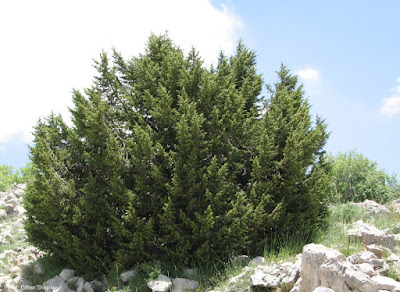Juniperus drupacea is widely distributed in the Mediterranean (Syria, Lebanon, Israel, Southern Turkey and Greece). It grows on of shallow, rocky soils, usually on calcareous or granite rocks at elevations of 600-1800 meters above sea level. It is hardy to USDA Hardiness Zones 7.
Juniperus drupacea also called as Syrian Juniper, is a species of the genus Juniperus. This species was described by Jacques Labillardière in 1791.
IDENTIFY JUNIPERUS DRUPACEA - SYRIAN JUNIPER PLANTS
Juniperus drupacea is widely distributed in the Mediterranean (Syria, Lebanon, Israel, Southern Turkey and Greece). It grows on of shallow, rocky soils, usually on calcareous or granite rocks at elevations of 600-1800 meters above sea level. It is hardy to USDA Hardiness Zones 7.
Syrian Juniper is a conifers tree which reaching up to 40 m tall and 1-2 m in diameter trunk with conic crown and brown-gray, longitudinally fibrous bark. The branchlets are triangular, with prominent ridges. The leaves are in whorls of 3, decurrent, linear-lanceolate, spiny-pointed, 15-25 mm long, 2.5-3.5 mm wide with 2 white lines above and broad green midrib, keeled below. The seed cones are berry-like, 20-27 mm long and 20-25 mm diameter, bluish-black or brown, bloomy, edible.
Limited use although its decay-resistant wood has made the larger trees valuable for timber. The cones, which have high levels of sugar have been used in Turkey for marmalade or as dried fruit.
JUNIPERUS DRUPACEA - SYRIAN JUNIPER PLANTS CARE AND CULTIVATION
The cultivation of these plants presents no special difficulties, if proper soil and exposure are available. The question of hardiness is, of course, all-important. It is not only the problem of temperature the given tree will stand, but also the exposure to winds, and, to a considerable extent, the source from which the tree is derived. If the plants are raised from seeds matured in similar or even more rigorous climates, they are usually more hardy.
Soils:
Juniperus drupacea prefer a well-drained porous gravelly subsoil, overlaid with a light sandy loam. They seem to be particularly happy in a soil underlaid with a porous glacial drift. In cultivation, however, they succeed very well in ordinary well-drained soil. When the plants are set in clay soil, which is often done, the soil should be thoroughly loosened by trenching or subsoil plowing, and well underdrained. Any available humus, woodashes, and well-rotted manure incorporated in the soil greatly aid in rendering it friable and porous for the roots.
Manures and mulches:
Mulching with ordinary well-rotted barnyard manure in late autumn affords much stimulus to growth. By the following spring the manure will be in a desiccated condition and can be incorporated with the soil. A heavy mulch of old straw, rotten hay, or any similar material over the roots, and this was maintained throughout the entire growing season is benefit to the plants in a more or less juvenile condition.
In many cases manure is not obtainable. In such event, newly moved plants should be heavily mulched with rotten straw, rotten hay, or any similar rubbish for a few years until they become established. The frequent stirring of the ground over the roots subsequently will conserve sufficient moisture.
An area extending from the stem to one to two feet beyond the branches, stirred up with hoe and rake perhaps five or six times throughout the growing season, is very beneficial in conserving the moisture around the roots.
Pruning:
Removal of the lower branches is a serious mistake, and, if healthy, they should be retained to the base. Pruning or disbudding can be intelligently performed to add much to the natural symmetry. The extraction or removal, early in spring, of the central or terminal bud, will tend to compel the branches which start from the side buds to spread apart and form a much denser growth. Cutting back the previous year's terminal growth to a strong bud or branchlet on the main limbs over the tree, if the plant is inclined to be thin in its branching, always produces a much denser lateral growth.
To develop very dense pyramidal habits, Syrian Juniper are often clipped with shears in spring before growth starts to produce density of growth. On private plantations it is better to use a sharp pruning-knife, or good standard pruning-shears, and cut the branches or projecting shoots back in "shingling" fashion. When carefully pruned in this way, the trees present a more pleasing appearance and do not show such a stiff aspect as when shorn with the shears.
Transplanting:
Transplanting can be done at all times of the year, excepting midsummer when they are in full growth. The best success is secured in spring when the buds begin to swell. From the end of August to the middle of September, if there have been abundant rains and the ground has been well soaked, is a very good time to move the plants. They may be planted late in autumn when circumstances compel it, but there is likely to be a considerable percentage of loss. Their roots are very susceptible to injury from exposure to the air, and the utmost vigilance should be exercised to keep them covered and moist.















COMMENTS